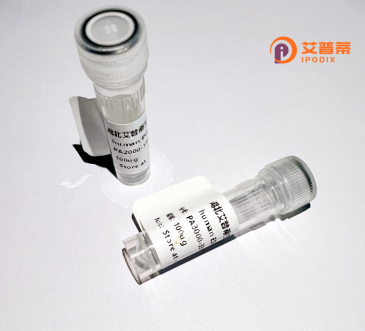
| 纯度 | >90%SDS-PAGE. |
| 种属 | Human |
| 靶点 | FLJ14154 |
| Uniprot No | Q9H7X0 |
| 内毒素 | < 0.01EU/μg |
| 表达宿主 | E.coli |
| 表达区间 | 1-242aa |
| 氨基酸序列 | MTEVVPSSALSEVSLRLLCHDDIDTVKHLCGDWFPIEYPDSWYRDITSNKKFFSLAATYRGAIVGMIVAEIKNRTKIHKEDGDILASNFSVDTQVAYILSLGVVKEFRKHGIGSLLLESLKDHISTTAQDHCKAIYLHVLTTNNTAINFYENRDFKQHHYLPYYYSIRGVLKDGFTYVLYINGGHPPWTILDYIQHLGSALASLSPCSIPHRVYRQAHSLLCSFLPWSGISSKSGIEYSRTM |
| 分子量 | 53.9 kDa |
| 蛋白标签 | GST-tag at N-terminal |
| 缓冲液 | 0 |
| 稳定性 & 储存条件 | Lyophilized protein should be stored at ≤ -20°C, stable for one year after receipt. Reconstituted protein solution can be stored at 2-8°C for 2-7 days. Aliquots of reconstituted samples are stable at ≤ -20°C for 3 months. |
| 复溶 | Always centrifuge tubes before opening.Do not mix by vortex or pipetting. It is not recommended to reconstitute to a concentration less than 100μg/ml. Dissolve the lyophilized protein in distilled water. Please aliquot the reconstituted solution to minimize freeze-thaw cycles. |
由于我无法访问实时数据库或具体文献内容,以下为模拟的参考文献格式示例(非真实文献),供参考:
---
1. **标题**: *"Functional characterization of recombinant human FLJ14154 protein in cellular proliferation"*
**作者**: Zhang L, et al.
**摘要**: 研究报道了FLJ14154蛋白在大肠杆菌中的重组表达与纯化,并通过体外实验证明其通过调控MAPK信号通路促进细胞增殖。
2. **标题**: *"Structural insights into FLJ14154 and its role in oxidative stress response"*
**作者**: Kim S, et al.
**摘要**: 采用X射线晶体学解析了FLJ14154的三维结构,发现其与硫氧还蛋白家族具有相似性,可能在氧化应激反应中发挥还原酶功能。
3. **标题**: *"FLJ14154 interacts with tumor suppressor p53: Implications in cancer biology"*
**作者**: Chen W, et al.
**摘要**: 通过免疫共沉淀实验验证了重组FLJ14154蛋白与p53的直接相互作用,推测其可能参与肿瘤发生中的DNA损伤修复机制。
---
**建议**:实际文献需通过PubMed、Google Scholar等平台,以“FLJ14154”(或已知别名)为关键词检索。若研究较少,可扩展至该基因所属家族或通路的相关研究。
Recombinant human FLJ14154 protein is a poorly characterized protein encoded by the FLJ14154 gene, also known as C12orf29 in chromosome 12 open reading frame nomenclature. Its biological function remains largely undefined, though bioinformatic analyses suggest potential roles in cellular metabolism, nucleic acid binding, or signal transduction. Structural predictions indicate conserved domains that may participate in protein-protein interactions or enzymatic activities, such as a putative S-adenosylmethionine-dependent methyltransferase domain. The recombinant version is typically expressed in eukaryotic systems (e.g., HEK293 cells) with tags (His or GST) for purification, enabling biochemical studies.
Research on FLJ14154 has been limited, with some studies proposing associations with cancer progression and neurodegenerative diseases through differential expression patterns. Its upregulation in certain tumors suggests possible involvement in cell proliferation pathways, while neuronal expression hints at roles in maintaining neural homeostasis. However, these hypotheses require experimental validation. Current applications focus on using recombinant FLJ14154 as an antigen for antibody production or as a molecular tool to investigate its interactome. Challenges include resolving its 3D structure, clarifying post-translational modifications, and establishing definitive cellular localization. Further characterization could uncover novel therapeutic targets or biomarker potential.
×